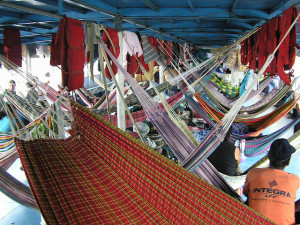In Manaus, Brazil during the 2014 Fifa World Cup, tourists are discovering the joys of riverboat travel. The tiny Amazonian city in Brazil wi ll be home to four of the World Cup games, but is very remote. While speedboats and cars may be a faster mode of travel than the riverboats, they lack the same authentic allure.
ll be home to four of the World Cup games, but is very remote. While speedboats and cars may be a faster mode of travel than the riverboats, they lack the same authentic allure.
The Almirante Barbosa is an example of a typical riverboat. As it travels past breath-taking views, the Almirante Barbosa holds dozens of passengers sleeping in hammocks. The weather, rocking motion of the boat and drum of the motor are masters at lulling a tourist to sleep.
The Almirante Barbosa and other boats like it are the lifeline of this part of the Amazon. In addition to passengers, they also carry staple goods to the isolated villages that are impossible to reach by any other method.
These wooden riverboats are ambling and very slow-moving. A trip that takes a motorboat about 4 hours will take one of these riverboats about 18 hours to make.
Though they are not the speediest method of travel through the Amazon, they do give a traveller the opportunity to take in the local scenes and wildlife as well as a window into the cultures of many of the towns along the Amazon.
The charm of these riverboats lies in the lazy pace, lazy passengers, and ample time to take in the scenery. Before boarding, it is advisable to bring a hammock as room aboard these vessels is quite sparse and hammocks are often even stacked in tiers, like bunkbeds. On the dock, Hammocks are sold and you can find any variety you want from $5 to about $100.
People leave the comfort of their hammocks towards sunset, when they relax with a drink in hand and watch the scenery flow by. While on board you get an idea of what life looks like in the Amazon such as floating houses, bars and general stores. All in all, taking a riverboat through the Amazon is a great way for tourists to become better acclimated with the jungles of Brazil.